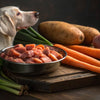Can I Cook Raw Dog Food? Understanding Nutrition and Safety for Your Canine Companion
- Houndsy
Table of Contents
- Introduction
- Understanding Raw Dog Food
- Can I Cook Raw Dog Food?
- Understanding Your Dog’s Dietary Needs
- The Role of Houndsy in Your Pet Feeding Routine
- Conclusion
Introduction
As pet owners, we are always seeking the best for our furry friends, especially when it comes to their nutrition. Did you know that an estimated 38% of dog owners are turning to raw feeding as a way to provide a more natural diet that reflects what their dog would consume in the wild? However, a common question arises: can I cook raw dog food? This inquiry reflects a fundamental concern for safety, palatability, and nutritional integrity.
In this blog post, we will explore the nuances of cooking raw dog food—examining benefits, downsides, safe cooking methods, and best practices. Our goal is to empower you with knowledge, helping you make informed choices about your pet's diet while maintaining the health benefits of feeding a raw diet.
Throughout this article, we invite you to reflect on your current feeding routines and consider how cooking, or not cooking, might impact your beloved dog's well-being. We will also examine how our innovative Houndsy Kibble Dispenser can play a pivotal role in simplifying your feeding process, whether you're opting for raw or cooked meals.
Let’s delve into the world of canine nutrition and the cooking debate around raw dog food—all designed to help your dog thrive.
Understanding Raw Dog Food
What Is Raw Dog Food?
Raw dog food, also known as a raw diet or biologically appropriate raw food (BARF), typically consists of uncooked meat, bones, fruits, and vegetables. This diet is intended to mimic what wild canines would naturally eat, preserving the essential nutrients that may vanish through cooking. Raw diets can present many benefits, such as improved coat condition, better digestion, and enhanced energy levels.
Benefits of Raw Feeding
-
Nutritional Integrity: Raw dog food retains essential enzymes, vitamins, and nutrients that can be lost during cooking. For instance, cooking can denature proteins and damage amino acids, creating a less available nutrient profile for dogs.
-
Improved Digestion: Many pet owners report better digestion and reduced stool volume when switching to a raw food diet. Raw ingredients are generally easier for dogs to digest since their stomachs are designed to handle raw proteins and bacteria.
-
Better Dental Health: Chewing on raw bones helps keep dogs’ teeth clean, reducing plaque and tartar buildup.
-
Allergy Management: Some pet owners have found that raw diets help manage food allergies by allowing greater control over the ingredients.
Concerns with Raw Feeding
Despite its benefits, raw feeding can lead to questions regarding safety and nutritional adequacy:
-
Pathogen Risks: Handling raw meat carries the same risks associated with human consumption of raw meat. Therefore, appropriate hygiene is essential—cleaning surfaces, washing hands, and avoiding cross-contamination.
-
Nutritional Balance: A poorly balanced raw diet can lead to deficiencies or imbalances in essential nutrients, causing health issues over time.
-
Risk of Cooking Bones: It's crucial to understand that while raw bones have dental and nutritional advantages, cooking bones makes them brittle and can cause splintering, posing a serious risk to your dog's gastrointestinal tract.
Can I Cook Raw Dog Food?
The Short Answer: Yes and No
While it is technically possible to cook raw dog food, doing so alters its nutritional properties, and there are several important factors to consider. Cooking can damage essential nutrients, such as enzymes and certain vitamins, ultimately diminishing the raw food's benefits.
Cooking and Nutritional Loss
Studies have shown that while minerals tend to be heat-stable, vitamins, especially B-vitamins, can suffer significant loss through cooking. For example:
-
Vitamins A and C: These are particularly sensitive to heat and may degrade significantly when exposed to high temperatures.
-
Proteins: Cooking can denature proteins, making them less usable by your dog's body.
To retain as much nutritional value as possible while cooking, consider methods that use lower temperatures or shorter cooking times.
Cooking Raw Dog Food Safely
If raw feeding remains a concern, there are several safe cooking methods available that minimize nutrient loss while ensuring that meals are safe and palatable for your dog.
1. Sautéing
Sautéing is preferred by many because it offers fast cooking while allowing control over temperature. When properly done, sautéing can maintain more nutrients than other cooking methods. Here's how:
- Use a little moisture in the pan—water or low-sodium broth.
- Sauté on medium to low heat for just 3 to 5 minutes. It's okay if the meat has a slight pink hue inside—the goal is to maintain moisture and delicate texture.
- Be cautious to keep any fat or juices that cook out as they contain valuable nutrients.
2. Slow Cooking
Slow cooking is another gentle method that can yield favorable results:
- Using a slow cooker, add your raw dog food and a sufficient amount of liquid (water or broth).
- Cook on low for 4 to 6 hours, allowing the food to become tender without overheating.
- This method is beneficial for larger batches and retains both moisture and nutrients.
3. Sous Vide
Sous vide allows for precision cooking in a temperature-controlled environment, ensuring even heat distribution:
- Seal raw food in a vacuum bag.
- Cook in a water bath set between 140°F to 160°F, maintaining temperature for at least an hour.
- This method allows you to cook food without overexposing it to high heat, preserving more of the nutrients.
4. Baking
Baking can also be used, though it requires careful attention to avoid overcooking:
- Preheat the oven to 350°F.
- Place raw food in a baking dish and cook for about 35-45 minutes.
- Monitor closely to ensure the food is lightly cooked while staying juicy and not dried out.
Cautions Against Microwaving
While some may consider microwaving a quick option, this method is not recommended. Microwaving can lead to uneven heating, which might leave some areas undercooked while others are overcooked, further complicating the nutritional integrity.
Understanding Your Dog’s Dietary Needs
When considering whether to cook raw dog food, it's also crucial to understand your dog’s individual dietary needs. Many dogs thrive on raw diets, but there are exceptions and variations in health that may necessitate a different approach based on age, breed, health status, or even preferences.
Special Needs Considerations
-
Senior Dogs: Older dogs may require softer meals due to dental issues, in which case gently cooking food can enhance its palatability and make it easier to chew.
-
Picky Eaters: If your dog is a reluctant eater, introducing warmed or lightly cooked raw food might encourage them to consume more readily.
-
Health Concerns: Dogs with digestive issues or specific medical conditions may require cooked meals for easier digestibility.
Reflecting on Your Feeding Routine
As we consider cooking raw food and its alternatives, we encourage you to examine your dog's overall diet:
- Are you seeing the health benefits as expected?
- Do you have a diverse range of different proteins and nutrients?
- Are there risks of foodborne illness that you’re uncomfortable with?
These reflections guide your decisions about whether cooking raw food might be appropriate for your scenario or if a high-quality raw option could work better.
The Role of Houndsy in Your Pet Feeding Routine
For pet owners seeking to simplify their feeding rituals, the Houndsy Kibble Dispenser is the perfect addition to your home. Our innovative design allows for an effortless feeding experience, whether you choose to serve raw, cooked, or kibble meals.
Key Features of the Houndsy Kibble Dispenser
-
Convenient Crank Design: The ergonomic crank at standing height eliminates the need for bending down, ensuring ease of use for pet parents of all ages.
-
Perfect Portion Control: Each crank delivers the intended amount, reducing waste and ensuring consistent servings.
-
Mid-Century Modern Aesthetic: Designed to complement your home decor, our dispenser is both functional and stylish.
-
Large Storage Capacity: Capable of holding 25-30 lbs of food, it keeps your pet's meals fresh with a BPA-free liner.
-
Auto-Locking Mechanism: Prevents accidental dispensing by curious pets or toddlers, enhancing safety.
Discover how the Houndsy Kibble Dispenser can elevate your dog-feeding experience. Explore our Houndsy Kibble Dispenser.
Conclusion
In conclusion, while cooking raw dog food is indeed possible, it comes with a host of considerations regarding nutritional integrity, digestion, and food safety. Understanding your dog's unique needs, alongside the principles of raw feeding, can guide you in making informed decisions about how to supplement or adjust their diet.
Whether you opt to incorporate cooked elements or stick with strictly raw feeding, our commitment at Houndsy is to support you in creating the best feeding experiences for your furry family members. As you navigate through these choices, don't forget to simplify your feeding routine with our stylish and innovative Houndsy Kibble Dispenser.
FAQ
1. What types of raw dog food are available?
Raw dog food comes in several forms, such as freeze-dried, frozen, or freshly prepared raw meat and vegetables. It's essential to choose a type that meets your dog's nutritional needs.
2. How often should I feed my dog raw food?
Feeding frequency can vary based on age, weight, and health. Generally, adult dogs are fed twice a day, but consult your veterinarian for specific recommendations.
3. Is it safe for my dog to eat cooked bones?
No, cooked bones are not safe. They can splinter and cause serious injuries to your dog's digestive system. Always stick to raw bones recommended for dogs.
4. Can I transition my dog from cooked to raw food?
A gradual transition is recommended to avoid digestive upset. Start by mixing small amounts of raw food with their regular food.
If you have any other questions or seek further guidance on transitioning between raw and cooked diets, don’t hesitate to reach out—or explore our Houndsy Kibble Dispenser to streamline your pet feeding experience!













